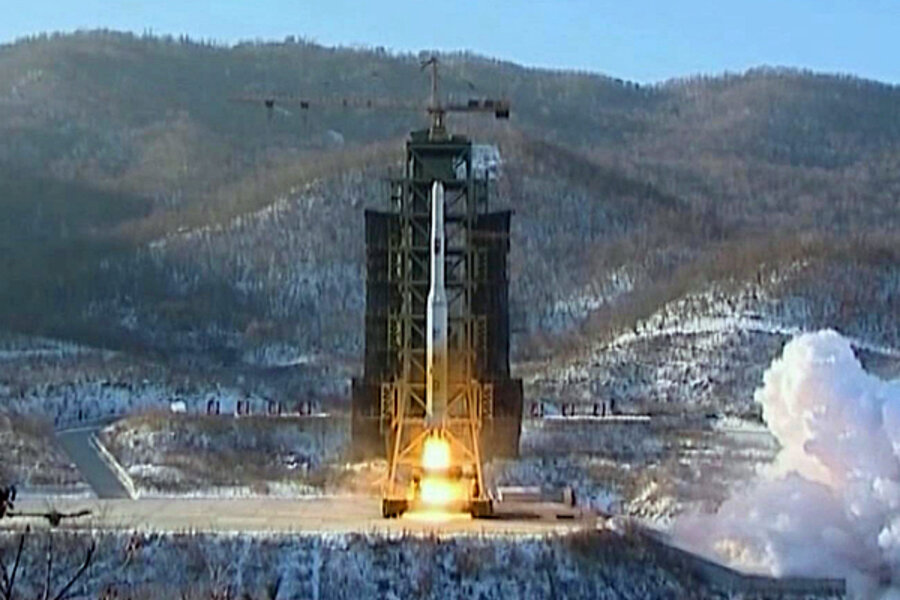Could North Korea hit the US with a missile?
| Washington
Could North Korea hit the United States with a ballistic missile? Could it mount a nuclear warhead on the tip of that missile?
The short answers to these questions are “in theory maybe, in practice probably not” and “no, not yet.” Longer answers revolve around the fact that experts in and outside the US intelligence community have struggled for decades to understand North Korea’s weapons programs and geopolitical intent.
Yet North Korea’s current and future military capabilities are among the most profound national security issues facing the US. They’ve taken on a new urgency this week in the face of renewed threats from the secretive Pyongyang regime. A launcher-rattling statement from North Korea on Thursday described the US as its “sworn enemy” and announced plans for a third nuclear test and more tests of long-range missiles in the months ahead.
“Settling accounts with the US needs to be done with force, not with words as it regards jungle law as the rule of its survival,” said the statement from North Korea’s National Defense Commission.
When it comes to ballistic missile capabilities, official US intelligence comments about North Korea tend to be fairly bland.
“North Korea continues to pursue the development, production and deployment of ballistic missiles with increasing range and sophistication,” judges a 2012 unclassified report from the Office of the Director of National Intelligence to Congress on threatening technology developments, for instance.
Yet sometimes top officials sound more concerned in their public statements. In January, a few weeks after North Korea had successfully placed a satellite in orbit with the Unha-3 space-launch variant of its longest-range missile, Secretary of Defense Leon Panetta told American troops, “North Korea just fired a missile. It’s an intercontinental ballistic missile, for God sakes. That means they have the capability to strike the United States.”
Secretary Panetta’s predecessor, Robert Gates, before he left office, warned that North Korea would have missiles capable of reaching the continental US by 2015 or 2016. US officials have also talked about a new, road-mobile North Korean missile that may or may not have intercontinental capabilities.
In theory, a ballistic missile based on the Unha rocket would be able to deliver a nuclear warhead-sized payload as far as Alaska, Hawaii, or part of the Lower 48, according to an analysis from the Center for Nonproliferation Studies (CNS) at the Monterey Institute of International Studies in California.
But previous launches of Unha-based rockets in 2006 and 2009 failed, raising questions about the technology’s reliability, CNS points out. In addition, it is a liquid-fueled rocket. This means it has to stand on the launchpad for hours, indeed days, for fueling. During that time it would be a sitting duck for attack.
“Although the Unha is clearly a step toward such a capability, it does not in itself represent a reliable system capable of delivering a nuclear weapon to the continental United States,” CNS judges.
North Korea has carried out two nuclear weapons tests and now says it is planning a third. The ability to produce a nuclear explosion, however, is not nearly the same thing as the ability to produce a device small enough to fit on the top of a missile.
As noted in a recent Congressional Research Service report, it is possible that Pakistani scientist A.Q. Khan provided North Korea with the same Chinese-based design for a small nuclear weapon that he provided to Libya and Iran. But most experts judge that North Korean scientists have yet to shrink their nuclear technology into a package small enough for missile delivery.
North Korean officials have long talked with bellicosity unmatched in geostrategic circles. Some say that when it comes to their nuclear missile programs, this chest thumping is largely a bluff – pro wrestling drama translated for an international stage.
Their past missile tests have been maximized to give the appearance of performance, and they have never exploded an actual nuclear warhead design, according to RAND analyst Markus Schiller.
Thus concerns about their missile tests are overblown, wrote Mr. Schiller in a lengthy 2012 report on North Korea’s missile programs.
“Every launch further depletes the limited North Korean arsenals, and North Korea gains no real experience from these events. Since the purpose of the launches seems to be political, the United States and other nations should downplay or even ignore them,” he writes.
Not all experts are so sanguine.
For instance, the South Korean Navy has managed to retrieve first-stage debris from North Korea’s December Unha-3 launch, and certain aspects of the space junk appear to reflect novel North Korean use of foreign-obtained technology.
The engine, for instance, appears to have new and slightly unexpected technological additions, such as the ability to steer with small auxiliary engines instead of jet vanes.
The United Nations Security Council unanimously passed a resolution Tuesday condemning December's rocket launch.
North Korea is not Iraq, whose ballistic missiles turned out to be cruder than US intelligence expected, points out Jeffrey Lewis, director of the CNS East Asia Nonproliferation Program, on the Arms Control Wonk blog.
“There has been a tendency to underestimate what North Korea can do in the space and missile field, and possibly with technology in general,” Mr. Lewis writes.






